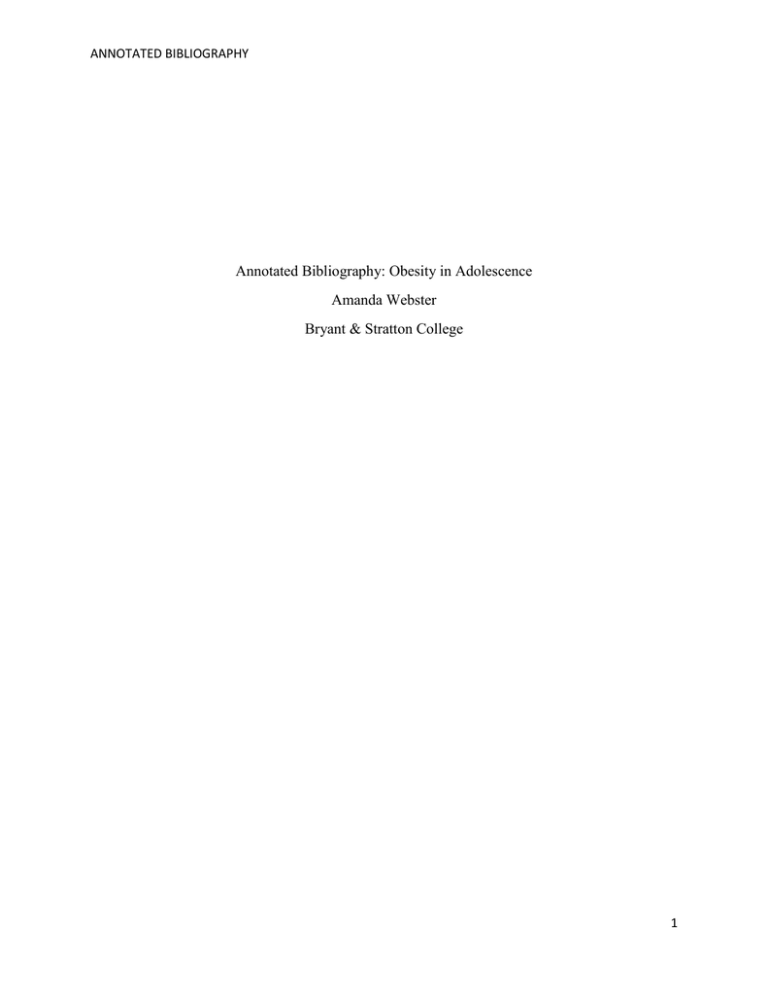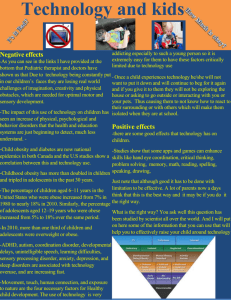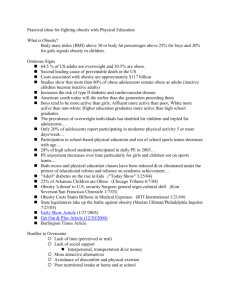151215051303_Annotated_Bibliography
advertisement

ANNOTATED BIBLIOGRAPHY Annotated Bibliography: Obesity in Adolescence Amanda Webster Bryant & Stratton College 1 ANNOTATED BIBLIOGRAPHY Cui, Wanjun, Zack, Matthew, & Wethington, Holly (September 2014) Health-related quality of life and body mass index among US adolescents. Quality of Life Research. Vol 23 Issue 7, p2139-2150 12p 4 Charts. Retrieved from http://search.ebscohost.com/login.aspx?direct=true&db=pbh&AN=97545810&site=eds-live A study examining the health related differences of adolescents of the US. Is obesity on the rise in the youth of America? In this study they looked at boys and girls ages 12 – 17. They studied 6,000 US adolescents in obese, overweight, normal weight, and even underweight. Boys and girls were studies separately. This took place over a nine year span from 2001 to 2010. Using Cross Sectional National Health and Nutrition Examination Surveys. They looked at the adolescent in four different categories of Body Mass Index (BMI). Self-rated health, physically unhealthy days, mentally unhealthy days and activity limitation days. Large gaps in self related health exists between normal weight adolescents. 18% of obese adolescents reported fair or poor health compared to only five percent of normal weight adolescents. 37% reported excellent or very good health. Obesity is on the rise in the adolescents of America. An estimated 15% of US adolescents are overweight. The strengths of this study are that they choose to study girls and boys separately, and to test in four different categories. Along with using 6,000 adolescent participants, all ranging in different categories of weight and even underweight. The only issue found to bring weakness to this study is that surveys were used and you don’t truly know if people are being honest when doing the survey so it brings questionable evidence to the study. 2 ANNOTATED BIBLIOGRAPHY Mirmirani P; Permanente Medical Group, Vallejo, California; Case Western Reverse University, Cleveland, Ohio; University of California at San Francisco, San Francisco, California. Carpenter DM. (March-April 2014) Skin disorders associated with obesity in children and adolescents: a population-based study. Pediatric Dermatology. Vol. 31 (2) pp 183-90 Retrieved from http://search.ebscohost.com/login.aspx?direct=true&db=cmedm&AN=24329996&site=eds-live Obesity in the adolescents of America has become a major health concern. One in every six children are obese and 31.6 percent are overweight. Are children who are obese or overweight at higher risk for skin disorders? In this study there were 248,775 participants who were all children from the United States of America. This study took place over a span of ten years, 2002 through 2012. Data was collected electronically on demographic characteristics, vital signs, outpatient and inpatient diagnoses and procedures, and ambulatory pharmacy and laboratory use are collected for all patients and maintained in the Kaiser Permanente Northern California (KPNC) data base. The study was approved by the KPNC Region Institutional Review Board and funded by the Community Benefit Program. Tests were done on different categories; insulin resistant, androgen excess, skin infections, dermatology encounters and inflammation. When it comes to insulin resistant the risk factor was the strongest with obesity. Disorders with androgen excess were less common than children with a normal body mass index. Children that are obese or overweight proved to be more prone to skin infections and fungal infections. Dermatology encounters were not greater with obese or overweight children than the average child with a normal body mass index. When studying inflammation it was found that children under ten years of age who are obese or overweight are more prone to have inflammation disorders. When breaking down different skin disorders in this study some were proven to be related to obesity, while others were found to have no ties with weight in a child. In this study the use of data was very promising, this was not a survey based study which makes the outcomes accurate. The fact that this was broken down into different skin disorders gives it a lot of strength. 3 ANNOTATED BIBLIOGRAPHY Taber, Daniel; Stevens June; Poole, Charles; Maciejewski, Matthew; Evenson, Kelly; Ward, Dianne. (February 2012) State Disparities in Time Trends of Adolescent Body Mass Index Percentile and Weight-Related Behaviors in the United States. Journal of Community Health 37(1): 242-252. Retrieved From http://search.ebscohost.com/login.aspx?direct=true&db=ccm&AN=104630558&site=eds-live There is conflicting evidence as to whether obesity in adolescence has reached a plateau in the U.S. Trends vary by state, experts are recommending exploring whether trends in weight-related behaviors are linked with changes in weight status trends. In 2001 they obtained survey data from 272,044 adolescents living in 29 different states. Ages ranged from 12 to 19 years of age and they continued to study this group of adolescents till the year 2007. The objective of this study was to build upon previous studies of obesity trends and address the gaps. They are estimating between state variations in adolescent’s time trends in body mass index (BMI) percentile and weight related behaviors. Youth Risk Behavior Survey (YRBS) data testing for non-linear trends and identifying behavioral, demographics and contextual factors that distinguish states with different trends. The results of these study’s among boys and girls the BMI percentile in 2001 was 57.67 and for the boys it was 63.57. In boys there was a modest increase overtime by 0.18 units per year. Among girls the BMI increased throughout the study time but the magnitude of increase declined 1.02 units from 2001 to 2002. After studying for multiple years and using data that was designed to represent each state individually the BMI percentile has not peaked in many of the states being studied. The strength of this study is that it was performed over a six year period using surveys of representative data throughout those years. The issue with this study is that they didn’t test all states, they only received information providing data for research for 29 out of 52 states. They were also limited to self- reporting behaviors which could also prove this study’s data to be untruthful and prove this study to be wrong in many ways. 4 ANNOTATED BIBLIOGRAPHY Richardson, A. S.; Deitz, W. H.; Gordon-Larson, P. (October 2014). The association between childhood sexual and physical abuse with incident adult severe obesity across 13 years of the National Longitudinal Study of Adolescent Health. Pediatric Obesity. 9(5): 351-361. (11p) Retrieved from http://search.ebscohost.com/login.aspx?direct=true&db=ccm&AN=103888250&site=eds-live This study estimates adult-onset obesity in individuals with history of childhood physical and / or sexual abuse. Comparing these results to individuals that did not report abuse in their childhood. Being exposed to sexual or physical abuse as a child may put that person at a higher risk for severe obesity as they get older. In this study they looked at 20,745 adolescents in grades seventh through twelfth. They studied non-minority and minority males and females. They also followed them throughout their life with four exams as they got older. This took place in 1994 and ended in 2009, a 15 year process for this particular study. 80 high schools and 52 middle schools were randomly selected for the study. During this study they used a wave schedule with four different levels, wave I, wave II, wave III and wave IIII. Height and weight were measured using normal procedures for wave I. They used this method so they could collect data from the same people over a long period of time. Wave I took place in 1994-1995 collecting data from the adolescents for the first step of the study. Wave II took place in 1996 where they followed up with the same participants from wave I the original study. These children were now in eight through twelfth grade, including dropouts, ages 12 to 22 years. In the third study wave III they followed up with the same people from wave I, ignoring wave II, measuring height and weight. At this point the participants were now 18 to 28 years old in 2001 and 2002. The next study wave IV they again followed up with the participants from wave I again, ignoring wave II and wave III, measuring height and weight. The participants were now 24-34 years old in the years 2008 and 2009. Only a quarter of respondents reported any abuse in their childhood making low markings for sexual abuse and an absence of physical abuse. The abuse rates varied with different sex and race/ ethnicity. Obesity was higher with minority than non-minority females who reported sexual abuse occurrences in their life. In this study they were unable to estimate male non-minority and minorities; due to only a few males reporting sexual abuse. Study’s found an association between obesity and childhood abuse, but there were too many inconsistencies by sex or race and abuse type. Only height and weight were measured over a period of time, with no other habits being part of the study or talked about other than sexual and physical abuse. With reports being submitted by surveys from participants the strength varies. This study’s strength is the amount of participants they have, and the years they dedicated to the research for this study. 5 ANNOTATED BIBLIOGRAPHY Rossen, Laruen M. (February 2014) Neighbourhood economic deprivation explains racial/ethnic disparities in overweight and obese among children and adolescents in the USA. Journal of epidemiology & Community Health. 68(2): 123-129 (7p) Retrieved from http://search.ebscohost.com/login.aspx?direct=true&db=ccm&AN=103994354&site=eds-live Low income families living in subpopulations are more likely to suffer with obesity. Do neighborhood-level socioeconomic have an impact on obesity in adolescents in the United States? Using the National Health and Nutrition Examination Surveys that are linked to census tract-level socioeconomic characteristics. Multilevel logistic regression models were used to examine neighborhood deprivation in association with odds of obesity. They had 17,100 participants ages 2 through 18. This took place from 2001 to 2007 a six year process. The results of this study they found that in areas where there is a lack of material benefits that are considered to be necessities; there were higher odds of obesity but only among children that lived above the poverty threshold. Neighborhood Socioeconomic Status (SES) is proven to partake as a contributing factor in obesity. One reason for this is inadequate access to supermarkets and resources for physical activity. In these neighborhood there is an abundance of corner stores and fast food outlets. Resulting in poor dietary intake and lower activity levels. When researching the SES levels of different neighborhoods it was only performed once when the study first started in 2001. There is a good chance that the SES changed over the six years it took for this study. Therefor the study may be proven wrong if someone researched the same thing but checked the SES every year the study collecting as much research needed to make it accurate. 6 ANNOTATED BIBLIOGRAPHY Phillips, K; Schieve, L; Visser, S; Boulet, S; Sharma, A; Kogan, M; Boyle, C; Yeargin-Allsopp, M. (October 2014) Prevalence and Impact of Unhealthy Weight in a National Sample of US Adolescents with Autism and Other Learning and Behavioral Disabilities. Maternal & Child Health Journal. 18(8): 1964-1975. (12p) Retrieved from Obesity is estimated as 20 percent among children aged 6-17, while studies have suggested an even higher estimated amount on children who have developmental disabilities. Is obesity more likely to happen to children who have learning and behavioral disabilities? National Health Interview Survey with parents reporting weight and height and development disorders were used in this study. There were 9,619 adolescents’ ages 12 to 17 years. This took place in 2008 through 2010, only two years. They divided the developmental disorders into subgroups such as Autism; intellectual disabilities; attention-deficit-hyperactive-disorder; learning disorder and other developmental delays. The Autism subgroup has the highest elevated level of obesity. The final study included 1,478 adolescents who had one or more learning / behavioral developmental disorders and 8,141 adolescents without any developmental disorders. In this study they found that US adolescents with learning / behavioral developmental disorders are 60 percent more likely to be obese and also 60 percent are likely to be underweight; than adolescents without developmental disorders. There are significant health risks with obesity in adolescents with developmental disorders. They also found that children with autism have a 31.8 percent chance of being obese. Some children with autism will only eat certain things, it gets looked at like at least their eating, even though what they eat is food with high calorie counts or food with high levels of sugar. Also medications given to children with developmental disorders have numerous side effects, including weight gain and increased appetites. Although they used surveys, the parents of the children were the ones filling them out and giving the information that was needed. This should make the answers more realistic and true, but not asking or knowing what medications these children were on if any and the side effects there could be a little leeway in the results. 7 ANNOTATED BIBLIOGRAPHY Cynthia L. Ogden, PhD; Margaret D. Carroll, MSPH; Brian K. Kit, MD, MPH; Katherine M. Flegal, PhD (February 2014) Prevalence of childhood and adult obesity in the United States, 2011-2012. Vol 311 Number 8. Retrieved from http://search.ebscohost.com/login.aspx?direct=true&db=cmedm&AN=24570244&site=eds-live The prevalence for obesity remained stable in 2003-2004 and 2009-2010, but there is still onethird of adults and 17 percent of the youth in America that are still obese and this is a cause for concern. This study is to provide the most recent estimates nationwide of obesity in children and analyze trends from 2003 to 2012. The National Health and Nutrition Survey was used in this study for height and weight of 9,120 participants. These surveys were collected in 2011 and 2012, but they studied ages separately across 5 periods. These periods were 2003-2004, 20052006, 2007-2008, 2009-2010, and 2011-2012. During this study they found that there was no change in high weight and recumbent length in infants and toddlers, neither in the range of two to 19 year olds, or in adults. There was a similarity between children and woman and there was also a decrease in obesity in children ages two to five years old. In studying adults there was a high rate for obesity in woman over the age of 60. This study concluded that there is no overall change in obesity in youth and adults, but the prevalence is still high. With that being sad there is still a need to study and surveillance the percentage of obese children in America. This study used surveys to obtain their information which can lead to using false information. Obesity has been an issue in America for some time now, all the studies including this one prove that something needs to change to help are future live longer. 8





